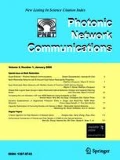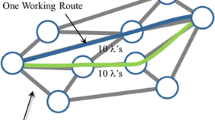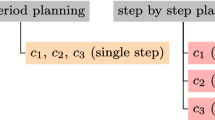Abstract
Almost all existing work on the design of survivable networks is based on a specific demand forecast to which one optimizes routing and transport capacity assignment for a single target planning view. In practice these single-forecast models may be used repetitively by a planner to consider a range of different scenarios individually, hoping to develop intuition about how to proceed. But this is not the same as having a planning method that can inherently and quantitatively consider a range of possible futures all at once. Our approach considers both the cost of initial design construction and the expected cost of possible augmentations or “recourse” actions required in the future, adapting the network to accommodate different actual future demands. In practice, these recourse actions might include lighting up a new DWDM channel on an existing fiber or pulling-in additional cables, or leasing additional capacity from third party network operators, and so on. A stochastic linear programming approach is used to achieve designs for which the total cost of current outlays plus the expected future recourse costs is minimized. Realistic aspects of optical networking such as network survivability based on shared spare capacity and the modularity and economy-of-scale effects are considered. These are not only important practical details to reflect in planning, but they give the “future-proof” design problem for such networks some unique aspects. For instance, what is the working capacity under one future scenario that may not waste capacity if that demand scenario does not materialize, because the same channels may be used as shared spare capacity under other future scenarios. Similarly economy-of-scale effects bear uniquely on the future-proof planning problem, as the least-cost strategy on a life-cycle basis may actually be to place more capacity today than current requirements would suggest. This is of obvious relevance to planners given the recent hard times in the telecommunications industry, causing a tendency to minimize costs now regardless of the consequences.
Similar content being viewed by others
References
R. Fildes V. Kumar (2002) ArticleTitleTelecommunications demand forecasting–a review International Journal of Forecasting 18 IssueID4 489–522 Occurrence Handle10.1016/S0169-2070(02)00064-X
T. Islam D.G. Fiebig N. Meade (2002) ArticleTitleModelling multinational telecommunications demand with limited data International Journal of Forecasting 18 IssueID4 605–624 Occurrence Handle10.1016/S0169-2070(02)00073-0
L.G. Kazovsky G. Khoe M. Deventer (November 1998) ArticleTitleFuture telecommunication networks: Major trend projections IEEE Communications Magazine 36 IssueID11 122–127 Occurrence Handle10.1109/35.733486
S. Verbrugge, D. Colle, M. Pickavet, P. Demeester, Common planning practices for network dimensioning under traffic uncertainty, 4th International Workshop on the Design of Reliable Communication Networks (DRCN 2003), Banff, Alberta, Canada, (October 19–22, 2003), pp. 317–324.
W. D. Grover J. Doucette M. Clouqueur D. Leung D. Stamatelakis (January 2002) ArticleTitleNew options and insights for survivable transport networks IEEE Communications Magazine 40 IssueID1 34–41 Occurrence Handle10.1109/35.978047
M. Clouqueur W. D. Grover (May 2002) ArticleTitleDual failure availability analysis of span-restorable mesh networks IEEE Journals on Selected Areas of Communications (JSAC) 20 IssueID4 810–821 Occurrence Handle10.1109/JSAC.2002.1003046
W. D. Grover (January 2004) ArticleTitleThe protected working capacity envelope concept: an alternate paradigm for automated service provisioning IEEE Communications Magazine 2 IssueID1 62–69 Occurrence Handle10.1109/MCOM.2004.1262163
M. Clouqueur W. D. Grover D. Leung O. Shai (October 2001) Mining the rings: strategies for ring-to-mesh evolution, 3rd International Workshop on the Design of Reliable Communication Networks (DRCN 2001) Budapest Hungary 113–120
J. Doucette W. D. Grover (October 2000) ArticleTitleInfluence of modularity and economy-of-scale effects on design of mesh-restorable DWDM networks IEEE JSAC 18 IssueID10 1912–1923
P. Kall S. Wallace (1994) Stochastic Programming John Wiley & Sons Chichester, New York
D. Leung, W. D. Grover, Restorable mesh network design under demand uncertainty: Toward “future proof” transport investments, Optical Fiber Communication Conference (OFC 2004), Los Angeles, California, (February 22–27, 2004), pp. ThO2.
Level 3 Communications, Inc. 2002 Annual Report. http://www.level3.com. [date accessed: June 4, 2004].
H. Courtney J. Kirkland P. Viguerie (November 1997) ArticleTitleStrategy under uncertainty Harvard Business Review 75 IssueID6 67–79
G. B. Dantzig (April – July 1955) ArticleTitleLinear programming under uncertainty Management Science 1 IssueID3/4 197–206
S. J. Hood S. Bermon F. Barahona (May 2003) ArticleTitleCapacity planning under demand uncertainty for semiconductor manufacturing IEEE Trans. On Semiconductor Manufacturing 16 IssueID2 273–280 Occurrence Handle10.1109/TSM.2003.811894
H. D. Sherali A. L. Soyster F. H. Murphy S. Sen (January 1984) ArticleTitleIntertemporal allocation of capital costs in electric utility capacity expansion planning under uncertainty Management Science 30 IssueID1 1–19
D. T. Gardner J. S. Rogers (Oct 1999) ArticleTitlePlanning electric power systems under demand uncertainty with different technology lead times Management Science 45 IssueID10 1289–1306
W. D. Grover (October 1997) ArticleTitleSelf-organizing broadband transport networks Communications in the 21st Century IEEE Proceedings: Special Issue on. 85 IssueID10 1582–1611
W. D. Grover, Mesh-based Survivable Networks: Options for Optical, MPLS, SONET and ATM Networking (Prentice Hall PTR, August 2003).
M. Clouqueur (November 2003) Availability of service in mesh-restorable transport networks University of Alberta Edmonton, Alberta, Canada
M. Herzberg, S. Bye, An Optimal Spare Capacity Assignment Model for Survivable Network with Hop Limits, (IEEE GLOBECOM 1994, San Francisco, USA), pp. 1601–1606.
R. R. Iraschko M. MacGregor W. D. Grover (June 1998) ArticleTitleOptimal capacity placement for path restoration in STM or ATM mesh survivable networks IEEE/ACM Transactions on Networking 6 IssueID3 325–336 Occurrence Handle10.1109/90.700896
W. D. Grover, M. Clouqueur, Span-restorable mesh network design to support multiple quality of protection (QoP) service-classes, 1st Int’l Conference on Optical Communications and Networks (ICOCN’02), Singapore, (Nov. 11–14, 2002), pp. 321–323.
S. Sen R. Doverspike S. Cosares (1994) ArticleTitleNetwork planning with random demand Telecommunication Systems 3 11–30
A. Gaivoronski, Stochastic programming approach to the network planning under uncertainty, Optimization in Industry 3, (John Wiley & Sons, 1995), pp. 145–163.
J. Kennington E. Olinick K. Lewis A. Ortynski G. Spiride (March 2003) ArticleTitleRobust solutions for the DWDM routing and provisioning problem: Models and algorithms Optical Networks Magazine 4 IssueID2 74–84
J. L. Higle S. Sen (1991) ArticleTitleStochastic decomposition: An algorithm for stage linear programs with recourse Mathematical Operations Research 16 650–669
Yu. Ermoliev R. J. Wets (Eds) (1988) Numerical Techniques for Stochastic Optimization Springer Verlag Berlin
J. M. Mulvey, Solving robust optimization models in finance, IEEE/IAFE 1996 Conference on Computational Intelligence for Financial Engineering, (March 24–26, 1996), pp. 1–13.
J. M. Mulvey R. J. Vanderbei S. A. Zenios (March 1995) ArticleTitleRobust optimization of large-scale systems Operations Research 43 IssueID2 264–281 Occurrence HandleMR1327415
D. Bai T. Carpenter J. Mulvey (July 1997) ArticleTitleMaking a case for robust optimization models Management Science 43 IssueID7 895–907
G. Birkan J. Kennington et al. (November 2003) ArticleTitleMaking a case for using integer programming to design DWDM networks Optical Networks Magazine 4 IssueID6 107–120
M. Pickavet P. Demeester (August 1999) ArticleTitleLong-term planning of WDM networks: A comparison between single-period and multi-period techniques Photonic Network Communications 1 IssueID4 331–346 Occurrence Handle10.1023/A:1010030918159
T. H. Wu R. H. Cardwell M. Boyden (October 1991) ArticleTitleA multi-period design model for survivable network architecture selection for SONET interoffice networks IEEE Transactions on Reliability 40 IssueID4 417–427 Occurrence Handle10.1109/24.93761
N. Geary, A. Antonopoulos, E. Drakopoulos, J. O’Reilly, Analysis of optimisation issues in multi-period DWDM network planning, Proceedings of the IEEE Conference on Computer Communications (INFOCOM), Anchorage, Alaska, (April 2001), pp. 152–158.
D. A. Schupke, C. G. Gruber, A. Autenrieth, Optimal configuration of p-cycles in WDM networks, IEEE International Conference on Communications (ICC 2002), New York City, NY, (April 28 – May 2, 2002), pp. 2761–2765.
D. Leung, W. D. Grover, Comparative ability of span restorable and path protected network designs to withstand uncertainty in the demand forecast, Proceedings of the 18th National Fiber Optic Engineers Conference (NFOEC 2002), Dallas, (Sept. 15–19, 2002), pp. 1450–1461.
R. Fourer D. Gay B. Kernighan (1993) AMPL: A modeling language for mathematical programming Fraser Publishing Company Danvers, MA
ILOG corporate website, ILOG Optimization Product – ILOG CPLEX, http://www.ilog.com/products/cplex/ [date accessed: June 4, 2004].
Author information
Authors and Affiliations
Corresponding author
Rights and permissions
About this article
Cite this article
Leung, D., Grover, W.D. Capacity Planning of Survivable Mesh-based Transport Networks under Demand Uncertainty. Photon Netw Commun 10, 123–140 (2005). https://doi.org/10.1007/s11107-005-2479-z
Received:
Revised:
Accepted:
Issue Date:
DOI: https://doi.org/10.1007/s11107-005-2479-z




